June 19, 2025 | 22:32 GMT +7
June 19, 2025 | 22:32 GMT +7
Hotline: 0913.378.918
June 19, 2025 | 22:32 GMT +7
Hotline: 0913.378.918
Editorial Board’s note:
According to a report from the Ministry of Agriculture and Rural Development (MARD), Typhoon No. 3inflicted significant damage on agricultural production, resulting in the flooding and loss of nearly 190,400 hectares of crops, over 48,700 hectares of vegetables, and more than 31,700 hectares of fruit trees. Additionally, approximately 3,270 aquaculture cages were destroyed, while nearly 21,800 livestock and over 2.6 million poultry perished.
The Vietnam Agriculture Newspaper has published a special issue entitled "Reconstructing Agricultural Production Post-Storms and Floods," with a focus on key sectors such as fisheries, livestock, crop cultivation, forestry, and water management infrastructure, including irrigation and dyke systems. The publication provides a detailed analysis of the current challenges, technical solutions, and offers policy recommendations aimed at facilitating a timely and effective agricultural recovery process.
Statistics following the historic Typhoon No.3, Quang Ninh is one of the areas that suffered the heaviest damage, especially in the fisheries sector. Many mariculture areas have been devastated, turning into empty waters, and countless families turned emty-hand. After the storm, what remains for Quang Ninh's fisheries seems to be only tears and mounting debts.
One of the pioneers of offshore aquaculture in Cai Rong town, Van Don district, is Ngo Nam Trung. We braved the waves of Bai Tu Long Bay to visit this bold man at his offshore farming area near Quan Lan in March of this year, when the marine farming movement in Van Don was reorganized in a more structured manner. Trung Nam Cooperative, which was established by Trung, was the initial community in Quang Ninh province to receive a sanction for offshore aquaculture.
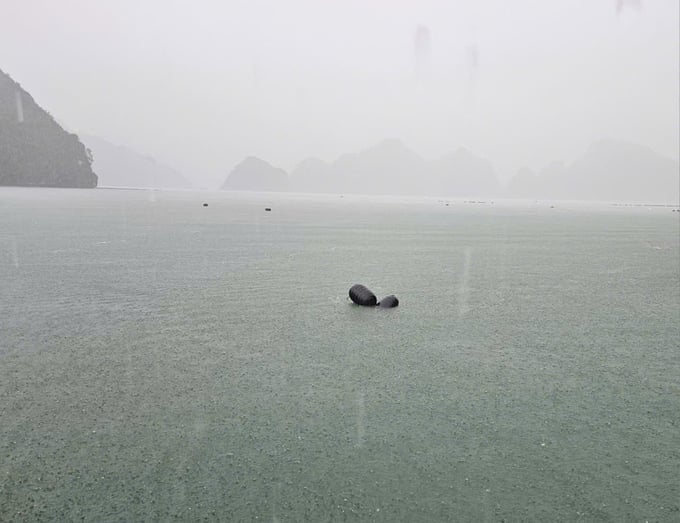
What remains in Bai Tu Long Bay after the storm. Photo: Hoang Anh.
I can still vividly recall that day; the waves were gentle and the weather was gorgeous. Amid the vast sea, Director Ngo Nam Trung, who was conversing while working, consistently encouraged the cooperative members to string juvenile oysters onto lines that were attached to the newly invested HDPE plastic buoys, which were replacing the old foam buoys. Other cooperatives, including Phat Co, Thang Loi, Kien Cuong, and Manh Duc, were conducting similar activities in their vicinity.
The entire harbor was adorned with countless rows of floating buoys and cages, each one meticulously arranged after the other. The work environment was lively and brimming with energy. By the conclusion of October, the correspondents intended to return to participate in the harvest alongside the locals. Even a modest estimate would result in approximately 4,000 tons with 800 bivalve lines. The locals would be unable to avoid prosperity, given the 23.8 thousand hectares of sea surface area that are designated for fish and mollusk cultivation in Van Don.
However, the man who has lost everything now sits before me with a bewildered expression. He appears to have aged by several decades. Director Trung Nam and the majority of marine cultivators in Van Don have been deemed incapable of recuperating as a result of Typhoon No. 3. Trung started the boat reluctantly when I suggested we head out to the bay, but his voice betrayed evident despair: "There's nothing left out there." Van Don's marine farmers lost everything as a result of that vengeful tempest. The more you possessed, the more you lost. Individuals who had less suffered less. However, there is currently no remaining possession.
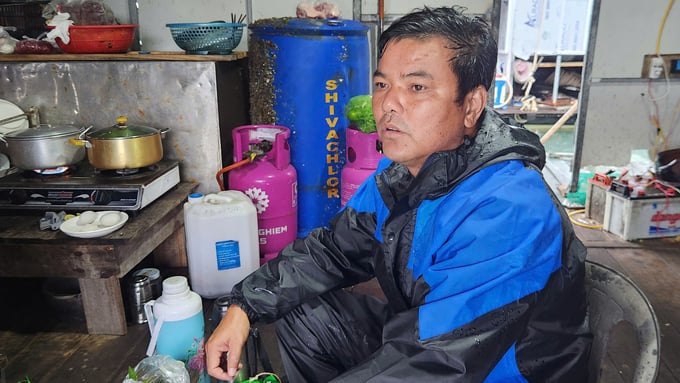
The bewildered look on the face of the Director of Trung Nam Cooperative. Photo: Tien Thanh.
In fact, Typhoon Yagi transformed the immense Bai Tu Long Bay into a desolate white expanse. As if an invisible force had cast a spell, thousands of cages, oyster farms, and fish aquaculture facilities had vanished, transforming the entire area into a barren sea. The once-thriving marine farming center revealed a scene of devastation as the fog began to lift and the rain stopped by noon. The sheltered areas of the estuary are littered with the tangled remains of plastic buoys and floating cages that wash ashore. The tempest had hurled others against the mountainside, resulting in their inclusion in the now-ravaged forest.
Trung, who had spent many years at sea, acknowledged that the hurricane would be severe and that there would be casualties. However, he had not anticipated the extent of the damage. The Van Don marine farmers were already anxious as the storm approached the Gulf of Tonkin, and they were intently monitoring its path. Everyone labored tirelessly for an entire week to fortify their cages and secure their floating homes prior to the storm.
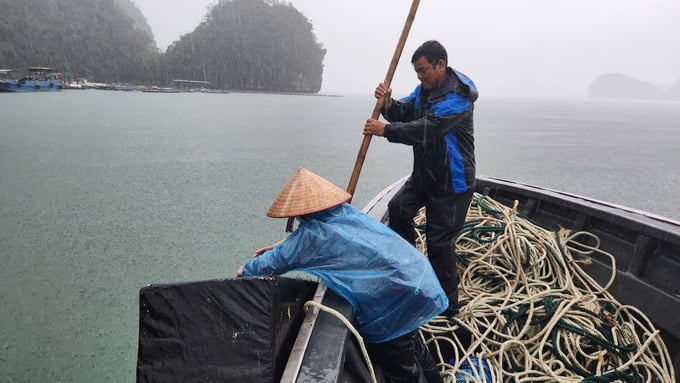
Salvaging after the storm. Photo: Tien Thanh.
Trung and his two brothers, who all invested in marine farming, were compelled to employ laborers to securely fasten the cages and floating houses to the largest boulders on the mountainside using ropes as thick as a man's thigh. Despite the local authorities' efforts to persuade and even forcibly evacuate the locals to shore, and despite the cries and demands of their wives and children to remain, a significant number of the men in Van Don secretly returned to their cages, where they were unable to return due to the storm.
Trung's family suffered a loss of 800 oyster lines, while Thuy and Thanh each suffered losses of 100–200 lines. The Typhoon resulted in the complete annihilation of Trung Nam Cooperative, as well as other cooperatives such as Phat Co, Kien Cuong, and Thang Loi, leaving all members with nothing.
The most distressing aspect is that the locals had recently made substantial investments to transition from foam buoys to HDPE plastic buoys. Each household invested billions of đồng, pledging all of their capital and even mortgaging their red books (land-use certificates) to borrow from the bank and invest in the sea. The storm has now completely devastated everything.
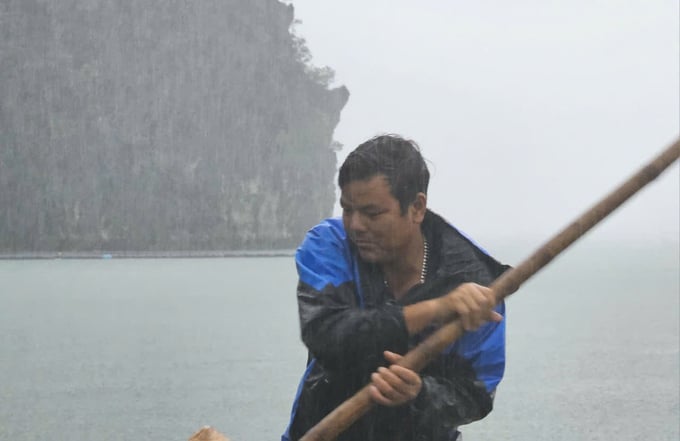
The sea is white with nothing left. Photo: Hoang Anh.
Trung calculated that his family had 800 oyster lines, which is equivalent to 80,000 buoys. He also stated that they had invested over 7 billion VND. Everything has been devastated by the storm. The oysters were approaching maturity, and we were only approximately one month away from harvest. In previous years, we would have harvested a minimum of 4,000 tons, as each line contained 10,000 immature oysters.
Even at the lowest retail price of 7,000 VND/kg, this amounts to 27–28 billion VND. Additionally, the investment in enclosures and labor expenses are not included. Presently, we possess nothing; there is not even an oyster shell remaining. We require employees to locate the buoys; however, no one is interested in the position due to the low pay.
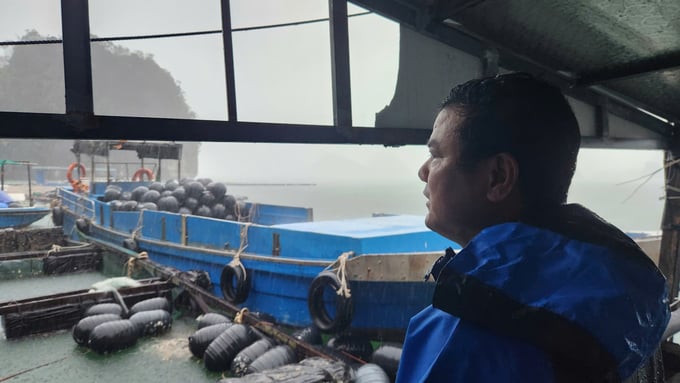
Director of Trung Nam Cooperative lost more than 30 billion VND. Photo: Hoang Anh.
"Immediately following the storm, my brothers and I embarked on a boat from Cai Rong to the island communes of Thang Loi, Ban Sen, Minh Chau, and Quan Lan." The vast ocean was now dotted with a few small black plastic buoys that locals had erected to indicate the positions of what was left. Before the storm, there were nearly one hundred marine agricultural cooperatives; however, they have disappeared entirely.
The number of oysters that a household cultivated was directly proportional to the amount of money they lost. The number of oysters lost was less for those with a smaller number, but in essence, everything was lost. Each household in Van Don had an average of 20–25 oyster lines, and they could harvest approximately 5 tons per line under normal circumstances. Trung's voice was strangled with emotion as he stated, "However, the survival rate is likely no higher than 0.1% at this time."
According to statistics from Cai Rong town, Typhoon No. 3 destroyed 71 cages, leaving 30 oyster farming households without any resources. Additionally, nine cement ships that were utilized by marine farmers were unable to withstand the typhoon and were submerged beneath the waves. In the Van Don district as a whole, preliminary statistics indicate that 1,340 households, which produce oysters, mussels, snails, and fish such as cobia, grouper, and pompano, were severely impacted, with the majority of their assets being completely destroyed.
Truong Thi Thu Huyen, the Head of the Agriculture and Rural Development Department of Van Don, conveyed her distress: "In Van Don, over 32,110 tons of aquaculture products have been lost..." Of this total, oyster farmers lost 25,637 tons, fish farmers lost 636 tons, and other marine farmers lost over 5,480 tons. The initial estimate of the damage exceeds 2.28 trillion VND. In summary, the marine farming sector of Van Don has been virtually eradicated by Typhoon No.3.
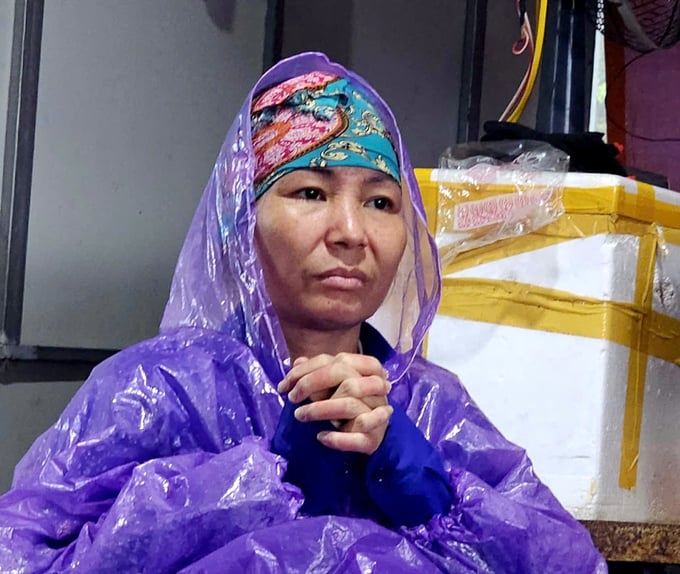
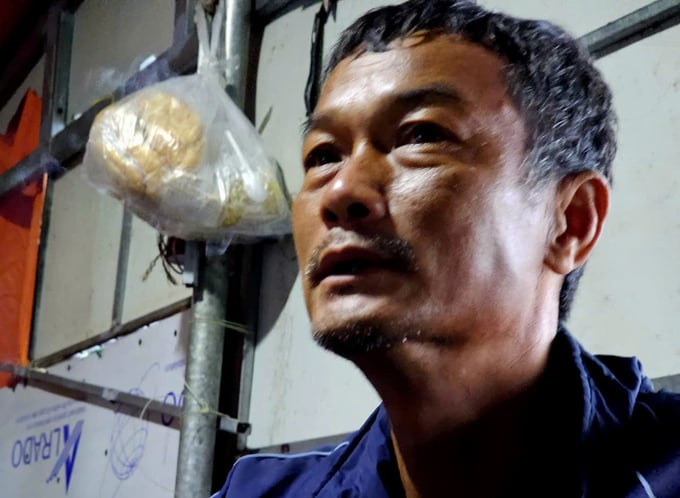
Tears of marine farmers in Van Don. Photo: Hoang Anh.
The family of Long Van Quang, the Director of Thang Loi Aquaculture Cooperative in Cai Rong town, experienced the most grievous loss. In the waters surrounding Ban Sen island commune, Quang was the largest grouper farmer, having toiled at sea for many years. This season, his losses totaled hundreds of billions of VND. Prior to the typhoon, Quang and five other individuals were reported to have elected to remain at the marine farming area to protect it.
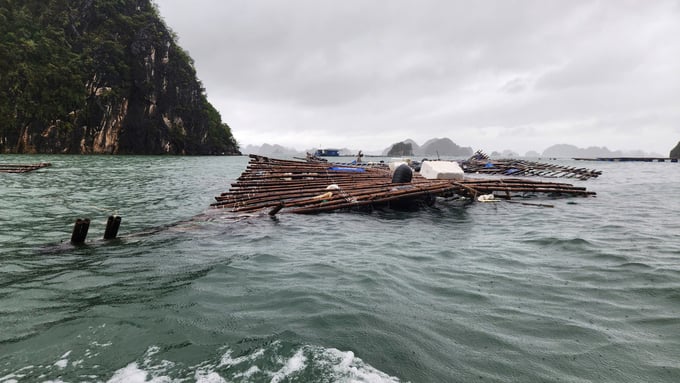
Billions of dollars disappear into the sea foam. Photo: Hoang Anh.
The six individuals believed that the composite ship, which was valued at billions of VND, was sufficiently durable. Consequently, they remained aboard. However, the waves carried away all the cages, which contained hundreds of tons of fish, each weighing 15–20 kg and being 5–7 years old, upon the storm's arrival. He not only forfeited his property but also his life. Five individuals were washed ashore at Van Hoa port after the composite ship capsized; however, Quang's body was not discovered until five days later.
However, Trung stated that a significant number of cooperative members have departed at this time, most likely due to the dread of overwhelming debt and the devastation at sea. The people can only hope that the majority of marine farmers in Van Don will be left destitute if the banks fail to restructure the debt.
Translated by Linh Linh
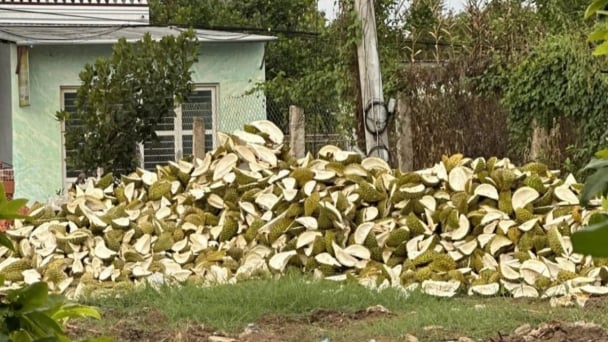
(VAN) The waste of resources from agricultural by-products and the situation of counterfeit and poor quality goods in production causing losses of thousands of billions were pointed out by the National Assembly deputy.
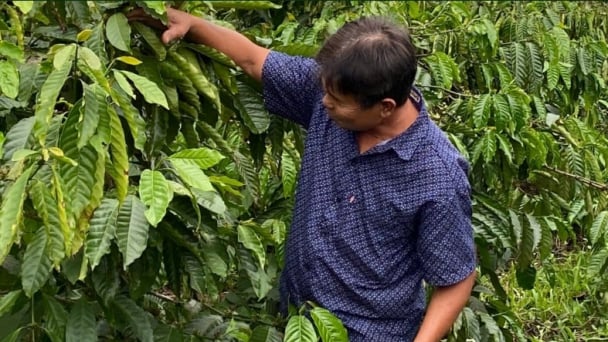
(VAN) After 5 years of implementation, the CAI initiative has helped coffee growers change their farming practices, moving toward responsible agriculture that meets global export standards.
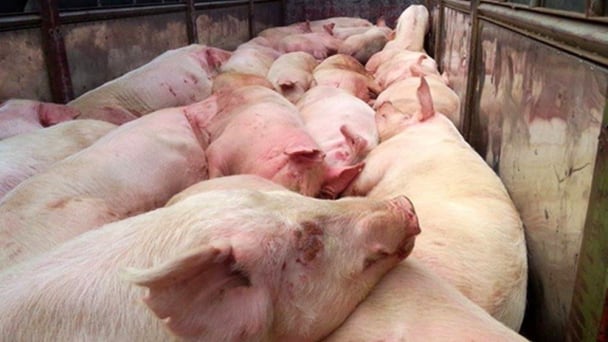
(VAN) The primary prerequisite for the comprehensive and robust integration of Vietnam's livestock sector into the global value chain is the establishment of a disease control system.

(VAN) The results of national programs are essential for establishing a contemporary livestock sector that is well-equipped to meet the demands of both domestic and international markets, with robust biosafety standards.
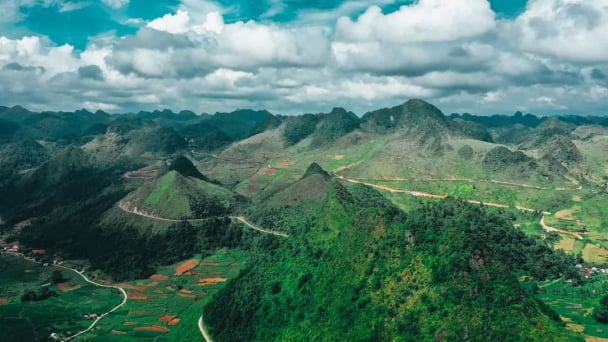
(VAN) The UNESCO Global Geopark revalidation of Non nuoc Cao Bang and the transition to a two-tier administrative model are presently undergoing a pivotal moment in Cao Bang, the northernmost province of Vietnam.
/2025/06/13/5330-2-004539_953.jpg)
(VAN) Changing policy mindset and removing investment barriers are urgent requirements to open up new development space for enterprises in the agricultural sector.

(VAN) The areas include the restoration of five million hectares of marine ecosystems.